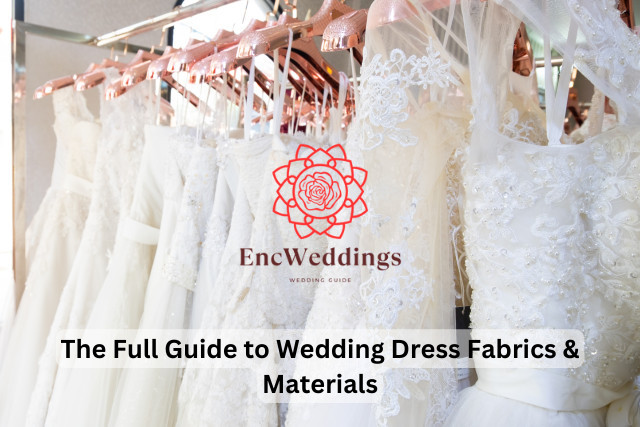The Full Guide to Wedding Dress Fabrics & Materials
Welcome to our ultimate guide to wedding dress fabrics and materials! Choosing the perfect wedding dress is one of the most important decisions a bride can make. The fabric and material selection not only affects the look and feel of the gown, but also influences its comfort and durability. With a seemingly endless array of options, selecting the right fabric and material can be overwhelming.
In this comprehensive guide, we will take you through the most popular fabrics and materials for wedding dresses, and help you make the right choice for your big day. From traditional silk to modern neoprene, we’ve got you covered. Whether you’re looking for a light and breezy summer dress or a warm and cozy winter gown, we’ll help you choose the perfect fabric and material to create the wedding dress of your dreams.
So, whether you’re a bride-to-be or a fashion enthusiast, this guide will be your go-to resource for everything you need to know about wedding dress fabrics and materials. Get ready to explore the world of silks, satins, laces, and more, as we walk you through the beauty and versatility of each option. Let’s dive in!
1. Introduction: The Importance of Fabric in Choosing Your Wedding Dress
Choosing the right fabric for your wedding dress is an important aspect of planning your big day. With so many styles, silhouettes, and designers to consider, understanding wedding dress fabrics can make the decision easier. Bridal fashion expert Mark Ingram explains that not all fabrics are created equally, especially when it comes to seasonality. The style and silhouette of the gown will also dictate the fabric direction, with some materials better suited for structured designs while others are great for flowing looks. [1][2]
2. Seasonality of Wedding Dress Fabrics
When it comes to wedding dress fabrics, it’s important to consider seasonality. Some materials, like heavy satin, can be uncomfortable during summertime weddings, while cotton may not be suitable for an autumnal ballroom reception. It’s crucial to choose a fabric based on the time of year to ensure comfort during the wedding ceremony and reception. However, the final decision should be up to the bride’s preference and vision for her big day. [3][4]
3. Wedding Dress Silhouettes and their Corresponding Fabric Types
The blog explains how different wedding dress silhouettes emphasize different parts of the body. For example, ball gowns have a fitted bodice with a dramatic flare at the waist, while mermaid dresses hug the body before flaring at the knee. Additionally, the type of fabric used for each silhouette can further enhance its look and feel. For instance, chiffon is perfect for A-line dresses, while crepe adds a gauzy and crinkled texture to soft silhouettes. [5][6]
4. Batiste: The Lightweight and Soft Fabric Perfect for Spring and Summer Weddings
Batiste is a transparent and lightweight fabric that is ideal for spring and summer weddings. It has a soft texture and comfortable feel, making it perfect for warm-weather months. This fabric is often used as an overlay or veil and creates an elegant and sophisticated look for any garden celebration. [7][8]
5. Brocade: The Structured Fabric Ideal for Formal Fall and Winter Nuptials
Brocade is the perfect wedding dress fabric for formal fall and winter weddings. This structured fabric is made from silk or synthetic fibers, with jacquard designs woven into it. Though it’s lighter than satin, its stiffness makes it ideal for structured gowns. Its texture and weight make it perfect for colder weather weddings, adding to the formal feel of the dress. [9][10]
6. Charmeuse: The Luxurious Fabric with a Soft Drape for Flowing Styles
Charmeuse is a lightweight, silky fabric with a beautiful drape that is perfect for flowing dress styles. Its glossy sheen on the outer side and matte texture on the inside give it a luxurious feel that is often used for empire waist gowns and beautiful drapery. It is a favorite fabric of renowned wedding dress designer Jenny Packham. [11][12]
7. Chiffon: The Sheer and Transparent Fabric Perfect for Bohemian Brides
Chiffon is known for its sheer and transparent style, making it perfect for the bohemian bride. Its light and airy structure works well for spring and summer weddings, while its weightless appearance lends itself to diaphanous silhouettes and goddess styles. However, it’s important to note that the delicate textile can be quite fragile and easily prone to snagging, pulling, or fraying. [13][14]
8. Crepe: The Gauzy and Crinkled Fabric Best Suited for Soft Silhouettes
Crepe is a gauzy and crinkled fabric that works best with soft silhouettes. The shapely material can be great for accentuating curves but also works well in stark minimalist designs and even bridal jumpsuits. Simple styles like mermaid or A-line dresses are classic choices for this fabric, and it’s a sophisticated textile that works year-round. [15][16]
9. Damask: The Lighter Weight Fabric with Raised Designs for Formal Wedding Styles
Damask is a lighter weight fabric with raised designs that make it perfect for structured styles with a formal flare. It is a great year-round option and its pattern is typically the same color as the base material. Damask is perfect for formal wedding styles and adds a touch of elegance to any bride’s special day. [17][18]
10. Lace: The Endless Options of Bridal Lace for Vintage-Inspired Styles
Lace is a timeless and romantic fabric option for wedding dresses. With its delicate texture and intricate details, lace can add depth and interest to any gown. From vintage-inspired styles to modern bohemian designs, there are endless options for incorporating lace into a bridal look. Whether used as a completely lace overlay or as subtle accents on sleeves or neckline, lace is a versatile choice for brides looking for a touch of elegance. [19][20]



:max_bytes(150000):strip_icc()/blakelivelyhighponytalsocial-0f3e136a3e0345de8aaf5759464da6d8.png?w=850&resize=850,550&ssl=1)